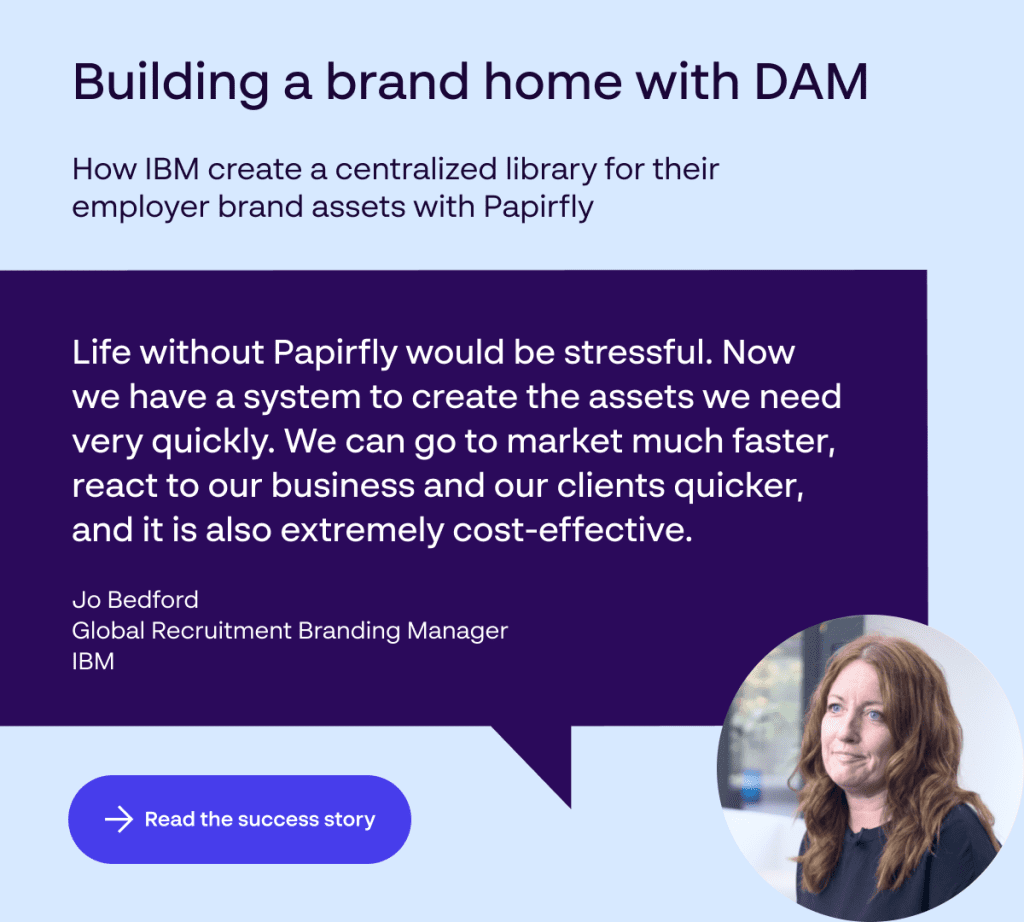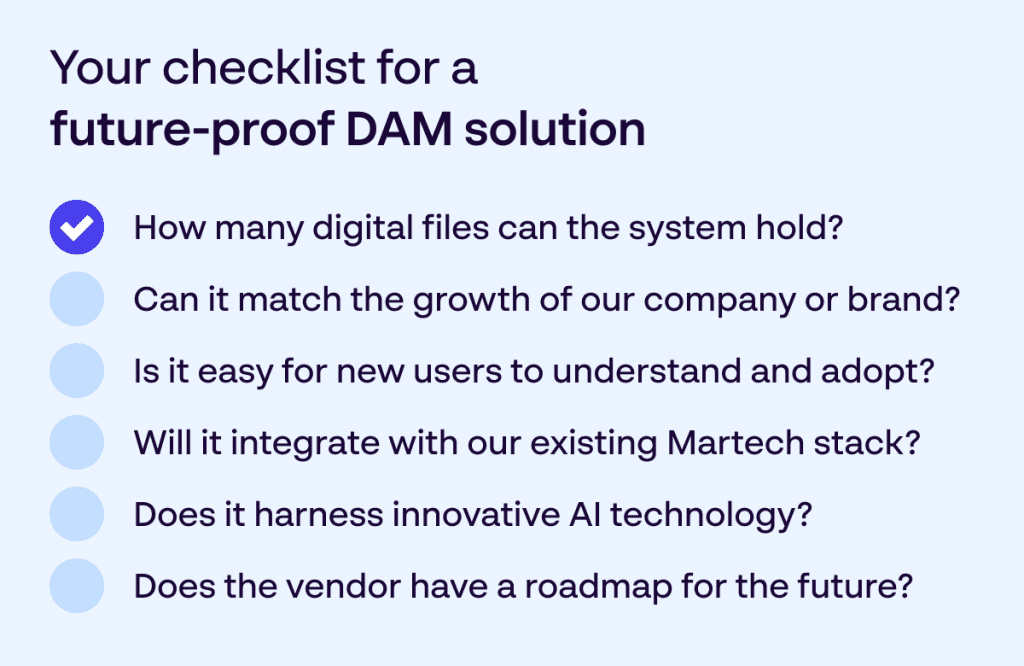Managing digital assets across multiple platforms, teams, and regions is already complex. As demand for on-brand content increases, marketing operations can’t afford to rely on systems that weren’t built to grow with them.
That’s why choosing the right Digital Asset Management (DAM) system matters – not just for today’s campaigns, but for your brand’s future.
Modern Digital Asset Management must be scalable
The global market for DAM software is expected to nearly quadruple by 2032. That’s because brands are producing more content, on more platforms, for more audiences than ever before.
Without a future-ready Digital Asset Management system, marketing teams will quickly hit operational limits. If your DAM can’t keep pace, your brand pays the price – through delays, duplicated efforts, or content going off-brand. That’s why scalability should be a non-negotiable.
In this article, we’ll walk through six essential questions to assess whether your DAM can scale with your needs.
DAM systems that aren’t future‑proof
Cause performance bottlenecks
Restrict marketing growth
Discourage user adoption
Become obsolete sooner
Cause performance bottlenecks
Restrict marketing growth
Discourage user adoption
Become obsolete sooner
6 questions to evaluate whether a DAM is future‑proof
1. Can it grow with your asset library
No question, your asset volume will increase in the future. Campaigns, formats, and channels will all evolve. It’s essential that your DAM software can handle not just today’s requirements, but also everything to come.
Ask about asset storage limits, upgrade options, and how easily capacity can be scaled. A future-proof DAM gives you room to grow without forcing a migration later.
45%
of marketers say at least half of their campaigns are content‑led
Source: World Media Group
45%
of marketers say at least half of their campaigns are content‑led
Source: World Media Group
2. Will it support the evolution of your company and brand?
New markets. New sub-brands. New regional teams. All can impact and reshape the nature of your brand. Your Digital Asset Management system must be able to flex to accommodate any eventuality. That means being able to support:
- Multiple brand identities
- Mult-language support
- Region- or campaign-specific asset portals
68%
of employees say they don’t understand their company’s vision
Source: European Leaders
68%
of employees say they don’t understand their company’s vision
Source: European Leaders
3. Is it intuitive for new users?
DAM software is only as powerful as the people using it. If your Digital Asset Management system is difficult to navigate, adoption will suffer – and so will your brand consistency.
70%
of software implementations fail due to poor user adoption
Source: ERP Software
70%
of software implementations fail due to poor user adoption
Source: ERP Software
Look for built-in features that promote usability, including:
- Drag-and-drop uploading to your digital library
- Smart search and auto-tagging
- Version control
- Role-based permissions
- Workflow automation
An effective brand portal also supports the long-term usability of your DAM, giving team members clear context for each asset, so they can use them correctly and consistently every time.
4. Can it integrate with your existing stack?
Most marketing teams are already juggling a dozen or so tools. Your Digital Asset Management software shouldn’t add complexity – it should reduce it. That’s why it’s so important to choose a DAM that easily integrates with your key platforms.
For example:
- CMS
- PIM
- Templating tools
- Creative software
The more your DAM connects to your existing brand ecosystem, the quicker and easier it is for teams to activate content.
5. Is it powered by AI?
AI isn’t a buzzword. It’s now a baseline. DAM systems that leverage AI deliver smarter tagging, faster search, and multilingual metadata, reducing manual work and improving asset findability. Emerging machine learning is set to go even further, recommending optimal assets for specific campaigns.
If you want to stay ahead, now and in the future, a DAM with a clear AI roadmap is critical.

6. Does the vendor have a product roadmap?
A Digital Asset Management system is an investment in your future. You deserve to know how it will evolve. Ask your vendor:
- What new features are planned?
- How do you gather customer feedback?
- How often are updates released?
A transparent, customer-focused roadmap shows that your DAM provider is in it for the long haul – just like you.

Choose a DAM built for tomorrow
As the battle to manage content across numerous channels grows more intense, having a DAM that you can depend on is a key differentiator. And in an always-on, content-heavy world, only scalable, intuitive, and connected systems will stand the test of time. So ask the tough questions now – and, if your current solution isn’t up to the task, consider one that is.
Papirfly’s Digital Asset Management and Templated Content Creation suite is designed to scale with your business, keeping your teams aligned, your assets on-brand, and your content strategy future-ready.
FAQs
Scalability ensures your DAM can grow with your asset library, team size, and brand structure. As content volumes, formats, and platforms expand, a scalable DAM prevents operational bottlenecks and avoids costly future migrations.
A future-ready DAM should support:
– Multiple brand identities
– Multilingual portals
– AI-driven search and tagging
– Flexible user permissions
– Integration with existing tools
– Transparent product roadmap for ongoing updates and innovation
To drive adoption, your DAM must be intuitive. Features like drag-and-drop uploading, smart search, auto-tagging, version control, and guided brand portals help users quickly find and apply assets – without training or guesswork.
Integration enables smoother workflows and faster content activation. A DAM should connect with CMS, PIM, creative platforms, and templating tools. This makes it easy for teams to publish, localize, and reuse assets directly from one system.
AI enhances DAM performance by automating metadata tagging, improving search accuracy, and personalizing content recommendations. A vendor with a strong AI roadmap ensures your DAM stays relevant and efficient as your needs evolve.


